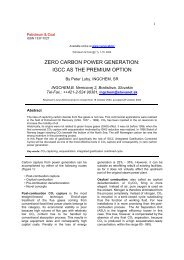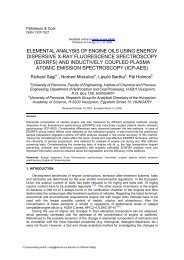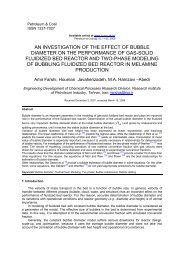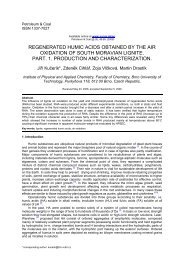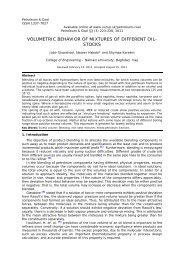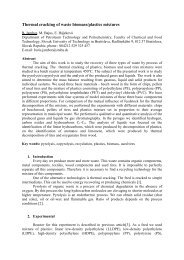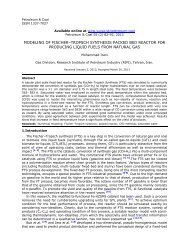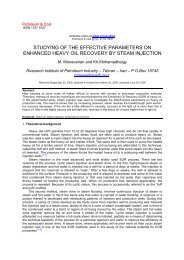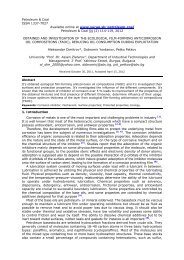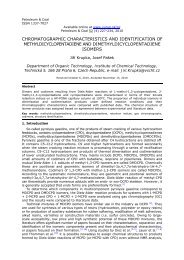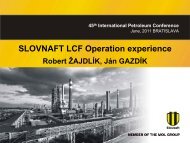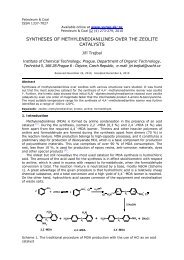MODELING AND SIMULATION OF AMMONIA SYNTHESIS REACTOR
MODELING AND SIMULATION OF AMMONIA SYNTHESIS REACTOR
MODELING AND SIMULATION OF AMMONIA SYNTHESIS REACTOR
Create successful ePaper yourself
Turn your PDF publications into a flip-book with our unique Google optimized e-Paper software.
Peet troollleeuum & Cooaal llIISSN 1337-7027Available online at www.vurup.sk/pcPetroleum & Coal 48 (2), 15-23, 2006<strong>MODELING</strong> <strong>AND</strong> <strong>SIMULATION</strong> <strong>OF</strong> <strong>AMMONIA</strong> <strong>SYNTHESIS</strong><strong>REACTOR</strong>Ali Dashti, Kayvan Khorsand 1 , Mehdi Ahmadi Marvast, Madjid KakavandResearch Institute of Petroleum Industry (RIPI), Pazhouheshgah Blvd.,Khairabad, Qom Road, Tehran, Iran.1 corresponding author, khorsandk@ripi.irReceived May 1, 2006; accepted June 24, 2006AbstractIn this paper an industrial ammonia synthesis reactor has been modeled. The reactor under study is of horizontaltype. This reactor which is under the license of Kellogg Company is equipped with three axial flow catalyst bedsand an internal heat exchanger in accompany with a cooling flow. The achieved modeling is one dimensional andnon-homogenous. Considering the sever effect of internal heat exchanger on reactor operation, it has beensimulated by calculation of film heat transfer coefficients in its tube and shell and then, taking into account theshell thermal resistance and fouling coefficient, obtaining the overall heat transfer coefficient. So in the developedsoftware, the heat transfer coefficient is first calculated using the conditions of the input flow to the exchanger andthen the input flows to the first and second beds are calculated. The differential equations have been solvedusing Rung Kutta 4 method and the results have been compared with the available industrial data. Finally thecapability of the developed software for industrial application has been investigated by changing the reactoroperation conditions and studying their effects on reactor output.Key words: ammonia, reactor, modeling, simulation1. IntroductionAmmonia Synthesis is a very important process in chemical complexes. Ammonia is the initialchemical material for a variety of industries. It is used in production of chemical fertilizers, explosivematerials, polymers, acids and even coolers. Simulation can play an important role to give an insightof the industrial units and hence simulation of Ammonia unit is very important to help us investigatethe different operation modes of this unit and optimize that. Ammonia synthesis loop is the mostimportant part of this unit which better understanding of its bottleneck can led us to make theoperation yield higher than before.2. Ammonia Synthesis LoopIn ammonia production unit, the synthesis loop is located after the syngas production andpurification units. Ammonia synthesis process takes place in high pressure and hence high powermulti cycle compressors are used to supply the required pressure. The Kellogg synthesis reactorincorporated in this loop is of horizontal type with three beds. To control the temperature between firstand second beds, an internal heat exchanger has been used in which the input feed to the first bedand the output gas from the same bed have thermal exchange. In addition to the mentioned heatexchanger, the quench gas flow is also used for control of temperature. The input feed to the reactor,is first divided into two parts, before entrance. One part is considered as feed and the other part asquench gas. The feed, after entering the reactor, passes through the empty spaces of the beds aswell as the reactor walls and gets slightly heated. When reaching to the end of the reactor, it passesthrough the shell of the internal heat exchanger and its temperature reaches 400 ºC. Tubes of theheat exchanger contain the output gas from the first bed. Quench gas is used to control the inlettemperature of the first bed. The required temperature for inlet of the first bed is 371 ºC. Output gas,
Ali Dashti et al./Petroleum & Coal 48(2) 15-23 (2006) 16after warming up, is then entered to first catalytic bed. Figure 1 depicts the schematic diagram of aKellogg horizontal reactor.Fig.1 Ammonia Synthesis Reactor - Kellogg method [1]When the gas passes the first bed and the reaction is taken place, its temperature increases andreaches 496 ºC. It then enters the tubes of the heat exchanger to cool down. Gas is then entered fromtop of the second bed. Temperature rises again as the reaction takes place in the second bed. Nospecific operation is carried out between beds two and three. In fact these two beds act as a singlebed whose length is twice the length of each bed. The catalyst of this reactor is magnetic ferro oxide.3. Mathematical ModelBy modeling of the synthesis reactor, temperature, concentrations and pressure profiles areobtained. Of course testing of the model based on the above parameters is achieved at the end ofeach bed as industrial data are not usually available along the length of the bed. The followingassumptions have been made for this modeling:1. One-dimensional Cartesian coordinate has been considered along with the bulk flow.2. Penetration of mass and heat is ignored, as the fluid velocity is very high in industrial scale.3. Density is constant4. Concentration and temperature on catalyst surface and bulk of gas are equal.5. The effects of penetration resistance in catalyst, temperature gradient and catalyst insideconcentration have been incorporated in the equations by a coefficient.Material balance (Molar) [2,3]Considering an element with height ofΔ x and cross section area equal to that of the bed we’ll have:uCAxuCAx + Δ xAccumulation = Consumption – Production + Output – InputThere shall be no accumulation as the system has been considered to be in steady state.( − r ) 0uCA − uCA1x+ AΔxη =x+ ΔxNH3 Dividing both sides of the equation byAΔxandΔx→0, we’ll have:
Ali Dashti et al./Petroleum & Coal 48(2) 15-23 (2006) 17( − r ) 0dcu +NHη =23dxThis equation can be re-written as below based on the Nitrogen Conversion Percentage shown by Z:dZdxηrNH3= 3οFN22Ain which the termF NοA2is the initial molar flow of N2.Reaction Rate [3,4,5,6,7,8]To calculate the rate of reaction, modified Temkin equation offered by Dyson & Simon in 1968 hasbeen used [4]⎡3α21−α⎛ a ⎞ ⎛ ⎞⎥ ⎥ ⎤⎢2 Ha⎜2NH⎟ − ⎜3R =⎟NH2kK3 aaN42⎢23⎣ ⎝aNH3⎠ ⎝aH2 ⎠ ⎦in whichα : Constant which takes a value from 0.5 to 0.75 in literature [8] .k : Rate constant for reverse reaction in: N2 + 3H2⇔ 2NH3Ka: equilibrium constantai: ActivityActivation can be written in terms of activation coefficient as below:fai= 5fiοi0fi: Reference fugacity. If the reference fugacity is considered to be 1 atm, then:aifi= = f = y φ P61iiiIn this equation φiis the fugacity coefficient and P is the total pressure.Below equations are the experimental ones for fugacity coefficient of hydrogen, nitrogen andammonia [4] .H2⎪⎧0.1250.5( ) ( ) ( )⎛3.8402T+ 0.541 −0.1263T−15.982−0.011901T−5.941= exp⎨eP − e P + 300[ e] ⎜e⎪⎩⎝P−− 300φ 7⎞⎪⎫⎟⎬⎠⎪⎭φN2= 0.93431737 + 0.2028538×10−62−62− 0.270727 × 10 T + 0.4775207 × 10 P−2φ = 0.1438996 + 0.2028538×10 T − 0.4487672×10NH3− 0.1142945×10−5T2−3+ 0.2761216×10T + 0.295896×10−6P2−3P−3P89
Ali Dashti et al./Petroleum & Coal 48(2) 15-23 (2006) 18In above equations T is in terms of Kelvin and P in terms of atmosphere.The equation of reverse ammonia synthesis reaction has been considered in base of Arrheniusformat.⎛ E ⎞k = k exp⎜− ⎟⎝ RT ⎠οο10k : Arrhenius coefficient equal to 8 .849×10E : Activation energy, which varies with temperature. Its mean value isR : Gas constant14kcal40765kmolIn 1930, Gillespie and Beattie have developed the following equation to calculate the equilibriumconstant [9] .−5−72log K a= −2.691122logT− 5051925×10 T + 1.848863×10 T2001.611+ + 2.689Tη Effect Factor [3,4,10]To investigate the effects of temperature and density of the catalyst interior and the differencebetween these parameters with those of the catalyst surface, an effect factor called η has beendefined. The general form of the equation defining this effect factor has been given below [10] .η b + b T + + + + +12= ο2 2 3 31b2Zb3Tb4Zb5Tb6ZThe above equation is in terms of T and conversion percentage. The coefficients of this equation forthree different pressures have been depicted in table 3 [4] .Pressure(bar)150225300Table 3. Coefficients of the correction factor polynomial in terms of pressurebοb1b2b3b4b5b6-17.539096-8.2125534-4.67572590.076978490.037741490.023548726.9005486.1901124.687353-1.08279e-4-5.354571e-5-3.463308e-5-26.42469-20.86963-11.280314.927648e-82.379142e-81.540881e-838.93727.8810.46Energy balanceEnergy balance is investigated on the same element on which mass balance has been considered.Accumulation = Consumed Energy – Produced Energy + Output Energy – Input EnergyIn steady state, the accumulation is zero.{ ρuCT −ρuCT } + AΔx( − ΔH) R 0A 13pxDividing the above equation bypx+ Δxr NHηAΔ x and3=Δx→0, we’ll have:dTρuC p+ ( − ΔHr) RNHη = 0143dxHeat CapacitanceThe following equation is used to determine the Heat capacitance:
Ali Dashti et al./Petroleum & Coal 48(2) 15-23 (2006) 19C2 3( a = b T + c T d )⎛ kj ⎞= 4.184i i i iT⎜ ⎟⎝ kmol ⎠pi+15Table 4. Coefficients of Cp polynomial for some component.Component a 2b ×10H2N2CH4Argon6.9526.9034.754.9675-0.04567-0.037531.2----5c ×100.095630.1930.303----5d ×10-0.2079-0.6861-2.63----In 1967, Shah has developed an equation for determination of ammonia heat capacity which hasbeen used in our modeling [11,12] .−2−52⎧6.5846− 0.61251×10 T + 0.23663×10 T −⎫⎪−93⎪⎪1.5981×10 T + 96.1678 − 0.067571P+ ⎪ ⎛ kj ⎞C PNH= 4.184⎨⎜ ⎟3⎪⎝ kmol.k ⎠⎪⎩−4( )( )⎪ ⎪ ⎬0.2225 + 1.6847 × 10 P T +−4−721.289×10 −1.0095×10 P T⎭16Reaction HeatElnashaie has developed a relation in 1981 for calculation of reaction heat which has been used inour modeling [13] .6⎧ ⎡ 846.609 459.734×10 ⎤⎫⎪−⎢0.54526+ +⎥P− 5.34685T−3⎪ ⎛ kj ⎞ΔH r= 4.184⎨⎣T T ⎦⎬ ⎜ ⎟⎪−32−63⎪ ⎝ kmol ⎠⎩0.2525×10 T + 1069197×10 T − 9157.09 ⎭17Pressure Drop [14,15,16]To calculate the pressure drop inside beds, Ergun equation has been applied. This relation for a onedimensionalflow is as below [15,16] .( 1−ε )z 22 150 μu1−ε ρuΔ P = −μ ∇ u = × −1.75×18323ε d ε dppAs most of the industrial data along the beds are not available, the model is tested based on theabove values at the end of each bed. Applying mass, energy and momentum balance on an element,derives the mathematical model. Considering all the points and discussions raised in the previoussections, the below set of three differential equations are derived.⎧dzηrNH3⎪ =ο⎪dx 2 FNA2⎪ dT⎨ρuCp+ ( − ΔHr) rNHη = 03⎪ dxz⎪dP150( 1−ε ) μu⎪ = −μ∇u = − × −1.7532⎩dxε dp2 1− ε ρu×3ε dp219
Ali Dashti et al./Petroleum & Coal 48(2) 15-23 (2006) 20The 4 th order Runge Kutta approach is used to solve the above set of equations. As this set ofequations is stiff, pressure drop equation is first taken out of the set and the new set with twoequations is solved using Runge Kutta numerical method. At each stage of the numerical solution,pressure drop is calculated by means of the temperature and concentration derived from that stageand in this case the three parameters i.e. temperature, pressure and conversion rate are determined.4. Modeling ResultsResults taken from simulation are compared with industrial data. Input conditions are as below [17] :Reactor input temperature: 266 °CReactor input pressure: 136.5 barDesired temperature for input gas flow to the first bed: 371 °CInput flow rate to reactor: 183600 kghrInput composition:y0,N= 0.23636802y0,H= 065670062y0,NH= 0.0269303y = 0.0597140,CH4y 0 ,Ar= 0.0202874The above has been calculated after mixing with quench flow and the total flow of the reactor isderived as 220200 hrkg .Fig 2. Changes of N2conversion rate along the bedsFig 2 illustrates the changes of N2conversion rate along the three beds. It is observed that changesalong the first bed are more sever than those of the second and third ones because of the lowerreaction product ( N2) content in feed of this bed. The deflection in the curve between first andsecond bed is because of change in the reaction speed, which is in turn resulted from gas cooling. Asno specific operation is carried out between second and third beds, the curve remains uniform alongthem.
Ali Dashti et al./Petroleum & Coal 48(2) 15-23 (2006) 21Fig 3. Molar fraction of the components along the bedsMolar fraction of the components along the bed can be deducted from the conversion rate and initialmole fraction values. Fig 3 depicts the molar fraction of the three main components of the reaction.Fig 4. Pressure Changes along the bedsFig 4 illustrates pressure profile along the beds. In practice, pressure drop is more than that shown bymodeling as in the related simulation the catalyst particles are assumed to be spherical. Ferritecatalyst doesn’t have a regular shape which increases the pressure drop. The deflection in the curvebetween first and second bed is resulted from the internal heat exchanger pressure drop.
Ali Dashti et al./Petroleum & Coal 48(2) 15-23 (2006) 22Fig 5. Temperature Changes along the bedsFig 5 illustrates the temperature changes along the beds. In first bed, as the ammonia concentrationis low, the reaction rate is very high and the temperature increases along the bed while approachingequilibrium at its end (the slope of the curve is reduced along the bed). After first bed, gas is cooleddown in internal heat exchanger causing that to get far from equilibrium. As it is observed in thefigure, the gas approaches equilibrium at the end of third bed and the temperature change is low.As previously mentioned, one of the capabilities of the developed software is investigation of changesin the unit outputs. Analysis of these results, can lead us to find bottlenecks and high productionways, etc. Fig. 6 and 7 illustrate some of the results.Fig 6. Effect of changes in flow rate on different parameters
Ali Dashti et al./Petroleum & Coal 48(2) 15-23 (2006) 235. ReferencesFig 7. Effect of changes in input NH3concentration on different parameters[1] R.W. Missen, C.A. Mims, B.A. Saville, “Introduction to Chemical Reaction Engineering &Kinetics” , Wiley, 1999.[2 J. Morud, “The dynamics of Chemical Reactors Whit Heat Integration”, Ph.D thesis, 1995.[3] S. S. Elnashaie, M. E. Abashar And A. S. Al. Ubaid, “Simulation and Optimization of anIndustrial Ammonia Reactor”, Ind. Eng, chem.. Res, Vol. 27,pp. 2015, 1988.[4] D.C. Dyson and J.M. Sicon. “A Kinetic Expression With Diffusion Correction for AmmoniaSynthesis on Industrial Catalyst”, Ind. Eng. Chem. Fundamental, Vol. 7, No. 4, pp. 605, 1986.[5] P.P. Singh and N. Saraf “Simulation of Ammonia Synthesis Reactor”, Ind. Eng. Chem.Process Des. Dev, Vol. 18, No.3, pp. 304, 1979.[6] P. Stoltze and J. K. Norshov, “ An Inter perdation of the High-pressure Kinetics of AmmoniaSynthesis Based on a Microscopic Model” J. Catal, Vol. 110, pp. 1, 1988.[7] L. D. Gaines, “Optimal Temperatures for Ammonia Synthesis Converters”, Ind. Eng. Chem,process Des. Dev, Vol. 16, No. 3, pp. 381, 1977.[8] A. Nielsen, “An investigation on Promoted Iron Catalysts for the Synthesis of Ammonia”, 3 rdEd, Jul. Gjellerups, Copenhagen, 1968[9] L. J. Gillespie, J. A. Beattie, Phys. Rev., Vol. 36, pp. 734, 1930[10] L. D. Gaines, “Ammonia Synthesis Loop Variables Investigated By Steady-State Simulation”,Chem. Engng Sci, Vol. 34, pp. 37, 1970.[11] B. Elverse, S. Hawkins, W. Russey, G. Schulz, “Ullman's Encyclopedia of IndustrialChemistry”, 5 th Ed, Vol. A2, 1993.[12] M. J. Shah, “ Control Simulation in Ammonia Production”, Ind. Eng. Chem., Vol 59, No 1, 72,1967.[13] A.T. Mahfouz, S.S. Elshishini, and S.S.E.H. Elnashaie, “Steady-State Modelling AndSimulation of an Industrial Ammonia Synthesis Reactor – I. Reactor Modeling “, ModelingSimulation & control, B, ASME press, Vol. 10, No. 3, pp. 1, 1987.[14] S.S.E. H. Elnashaie and S.S. Elshishini, “Modeling, Simulation, and Optimization of IndustrialFixed Bed Catalytic Reactors”, G&B Science, 1993.[15] S. Ergun, “Fluid Flow Through Packed Columns”, Chem. Engng. Prog., Vol 48, No 2, pp. 89,1952.[16] F. Zardi, D.Bonvin, “Modelling, Simulation and *Validation for an Axial- Radial AmmoniaSynthesis” , Chem. Engng Sci., Vol. 47, No. 9-11 , pp. 2523, 1992.[17] “Feasibility Study on Technology Transfer and Localization of Ammonia Synthesis Process inIran”, Project report, Research Institute of Petroleum Industries, 2001.



